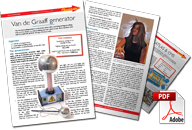Hydrogen balloon
You feel the shock wave as the fireball of a hydrogen explosion rises from a recently-lit balloon. This demonstration is a truly spectacular, if slightly gratuitous, reminder of where the protons accelerated in the LHC are found.
Apparatus
1 × hydrogen cylinder
1 × hydrogen regulator with flashback arrestor
3 × balloons (helium-grade latex deflate slower)
3 × balloon weights
string
1 × candle
1 × long stick
1 × lighter
Safety
This demonstration is both very hot and very loud. Be sure presenters wear eye and ear protection, that the audience is sat well back and that they cover their ears during the explosion. Also be aware of potential fire risks.
The demonstration
- Before the show, fill the balloons with hydrogen and attach them with string to the weights.
- Light the candle on the end of the stick.
- Standing well back, use the candle to light the balloon.
- Watch as a spectacular fireball ensues.
Vital statistics
reaction:
2H2 + O2 → 2H2O
adiabatic flame temperature:
2200°C
How it works
Hydrogen is used as a source of protons in the Large Hadron Collider. The simplest element, it is made up of just one proton and one electron, and that electron can be stripped off with electrostatic fields, leaving the proton to be accelerated in the collider.
A more visually exciting use of hydrogen is as a highly efficient fuel source: liquid hydrogen and liquid oxygen are used to create the huge controlled explosions which lift rockets off the ground and into space. Here, a balloon full of hydrogen and atmospheric oxygen are combined to make a slightly less controlled explosion.
We often explode two of these balloons to close the show as well as the one which is strictly necessary for explanation early on!



